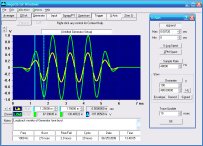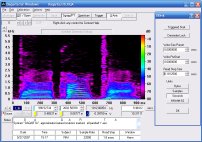![[LogoShip]](logo5.png)
Software for Windows
Science with your Sound Card!


Features:
Oscilloscope
Spectrum Analyzer
8-Channel
Signal Generator
(Absolutely FREE!)
Spectrogram
Pitch Tracker
Pitch-to-MIDI
DaqMusiq Generator
(Free Music... Forever!)
Engine Simulator
LCR Meter
Remote Operation
DC Measurements
True RMS Voltmeter
Sound Level Meter
Frequency Counter
Period
Event
Spectral Event
Temperature
Pressure
MHz Frequencies
Data Logger
Waveform Averager
Histogram
Post-Stimulus Time
Histogram (PSTH)
THD Meter
IMD Meter
Precision Phase Meter
Pulse Meter
Macro System
Multi-Trace Arrays
Trigger Controls
Auto-Calibration
Spectral Peak Track
Spectrum Limit Testing
Direct-to-Disk Recording
Accessibility
Data Logger
Waveform Averager
Histogram
Post-Stimulus Time
Histogram (PSTH)
THD Meter
IMD Meter
Precision Phase Meter
Pulse Meter
Macro System
Multi-Trace Arrays
Trigger Controls
Auto-Calibration
Spectral Peak Track
Spectrum Limit Testing
Direct-to-Disk Recording
Accessibility
Applications:
Frequency response
Distortion measurement
Speech and music
Microphone calibration
Loudspeaker test
Auditory phenomena
Musical instrument tuning
Animal sound
Evoked potentials
Rotating machinery
Automotive
Product test
Contact us about
your application!
Magnitude via Vector Sum
It often happens that we can't directly measure the amplitude and phase angle of a sinusoid, but instead we measure its sine and cosine "component" amplitudes. In the sine wave clock example we measured the sine component of the clock face (the height of the hand's pointer) to get our sine waveform. The cosine component is measured similarly, as the length of the "shadow" of the hand on the horizontal axis:
We can thus find the true amplitude or "magnitude" as the hypotenuse of this right triangle by taking the square root of the sum of the squares of the sine and cosine components. This is called the "vector sum" of the components. Similarly, we can find the phase as the angle whose tangent is equal to the sine component divided by the cosine component.
The sine and cosine components are often referred to as the "in-phase" and "quadrature" components, especially in discussions of older analog methods. Engineering math types prefer to use "real" for the cosine component and "imaginary" for the sine component, corresponding to a wonderfully intimidating exponential expression called "complex notation", perfect for casual dining conversation and impressing uninitiated audiences.
See also Sine Wave Basics, Sine Wave Phase, Making Waves via Sine Wave Synthesis
- Back to Sine Wave Phase
- Ahead to Making Waves via Sine Wave Synthesis
- Daqarta Help Contents
- Daqarta Help Index
- Daqarta Downloads
- Daqarta Home Page
- Purchase Daqarta
Questions? Comments? Contact us!
We respond to ALL inquiries, typically within 24 hrs.INTERSTELLAR RESEARCH:
Over 35 Years of Innovative Instrumentation
© Copyright 2007 - 2023 by Interstellar Research
All rights reserved